Qmarkets is an innovation management platform designed to help organizations manage their innovation process.
Like all platforms, it may be a good option for certain teams and situations, but it can also present a few limitations.
Some reviews mention that you have to contact their customer support team to customize the idea evaluation workflow around your processes or create new workflows to implement different types of ideas. You can’t customize or create new workflows on your own.
This leads users to either push all ideas through a single workflow or export them to an external project manager to plan validation and implementation tasks. As we’ll explain below, idea evaluation workflows are critical to a successful innovation program, and different kinds of ideas need different workflows.
To help innovation managers choose customizable and scalable innovation management software, we compiled a list of the five best Qmarkets alternatives below.
We start by discussing our innovation management platform, InnovationCast, and how it allows innovation managers to configure idea evaluation workflows without submitting requests to our team.
If you’d like to see how you can create unlimited idea evaluation workflows with InnovationCast, book a free demo with our team.
1. InnovationCast
Innovation Management Software with Customizable Evaluation Workflows
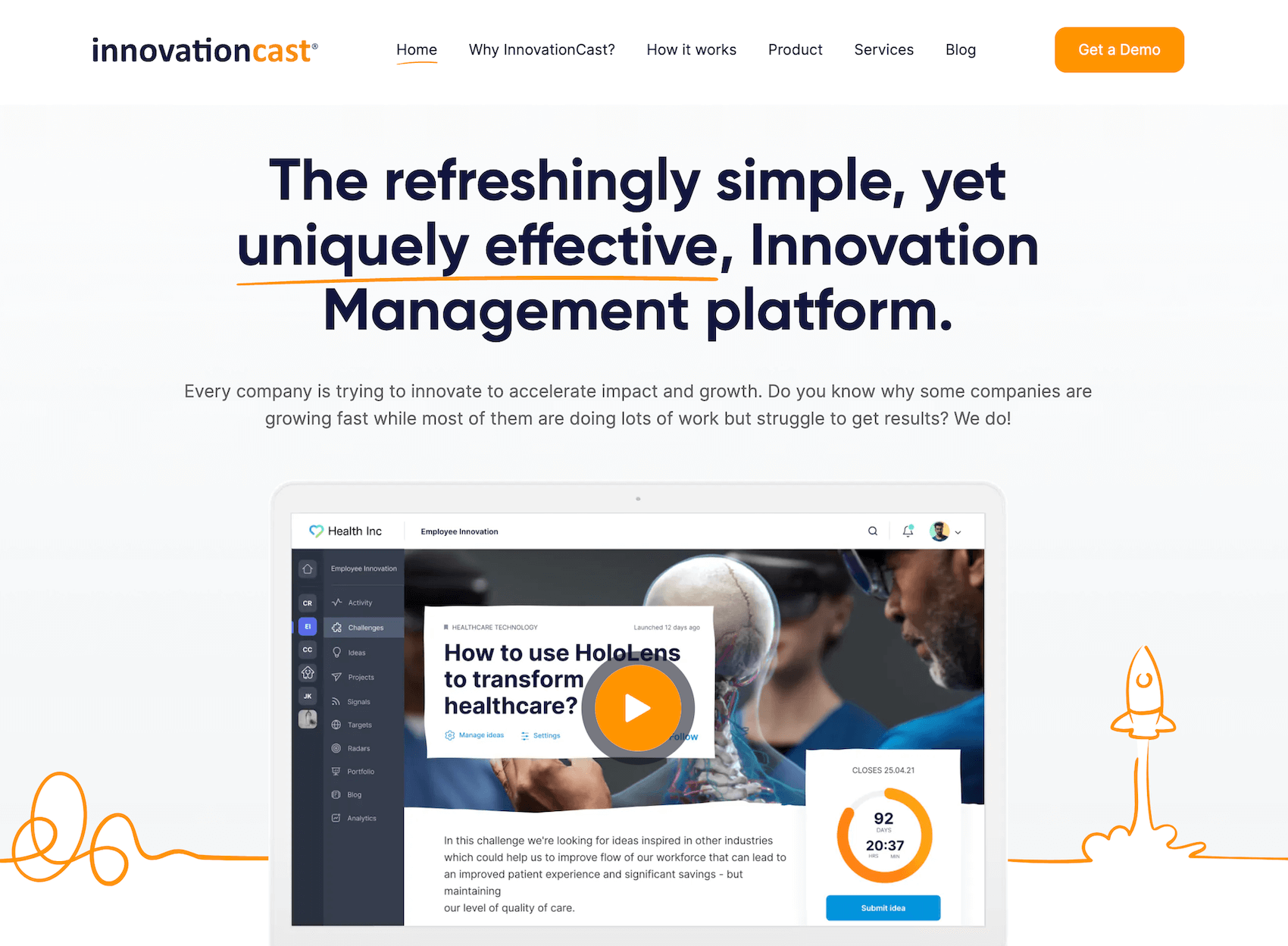
InnovationCast is an extensive innovation management platform that facilitates the entire innovation process from start to finish. Our solution is configurable and scalable, so organizations can easily customize features and settings to best support the specifics of their innovation processes.
Using our idea collection features, innovation managers can invite internal and external users to submit ideas aligned with their innovation strategy.
Then, innovation managers can set up any number of idea evaluation workflows to properly evaluate and validate ideas. These workflows can be customized — depending on the type of innovation at hand — to include steps like sketching an MVP, building a business case, or conducting a financial risk analysis.
For example, new product ideas in biotech will naturally have different evaluation steps than student experience ideas at a university. Importantly, we designed InnovationCast to let organizations create as many different idea evaluation workflows as needed.
Let's review each of these features in more detail so you can see how our platform works.
How Innovation Managers Can Collect Ideas Relevant to Their Priorities & Objectives
In order to help innovation managers collect high-quality ideas aligned with their priorities, we designed InnovationCast with two idea collection features:
Innovation Categories — Users can submit innovative ideas for pre-defined topics anytime. This push approach encourages employees to experiment with unforeseen ideas. This is a bottom-up approach that can eventually shape the company’s strategy.
Innovation Challenges — Innovation managers can launch challenges asking users to submit ideas to address opportunities, problems or customer needs already identified by the company. This is a top-down approach driven by the company’s strategy and managerial levels.
With “Always On” Idea Submission, Users Can Submit Innovative Ideas Anytime
Innovation managers can use our "Always On" idea collection feature to ask employees and outside users to submit relevant ideas for the organization based on predefined topics.
This could be launching new products, improving internal processes, or finding new market opportunities.
To keep all idea submissions centered around the innovation department’s priorities, innovation managers can set up accepted categories for ideas. When a user goes to submit an idea, InnovationCast asks them to sort their idea into one of these categories. This helps innovation managers exclusively collect ideas based on assigned priorities.
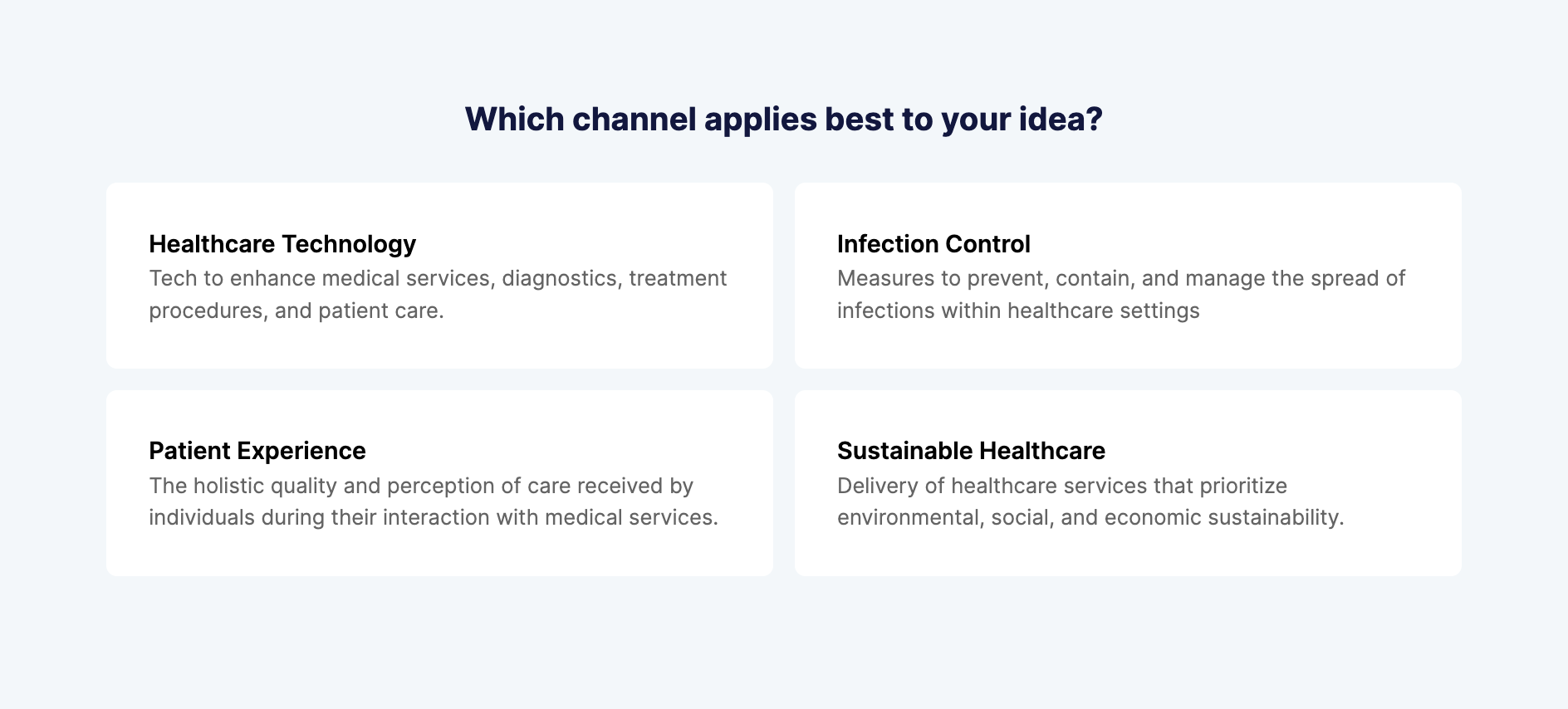
Using “Challenges”, Innovation Managers Can Call Users to Submit Ideas on Specific Goals, Problems or Opportunities
If innovation managers need ideas on current company priorities, they can create an Innovation Challenge. These are time-bound requests for users to submit ideas around strategic targets or important issues the company is facing.
Innovation managers can attach additional resources like market research data, customer interviews, and press releases to each challenge, providing users with the background information they need to understand the priority and who their ideas can benefit.
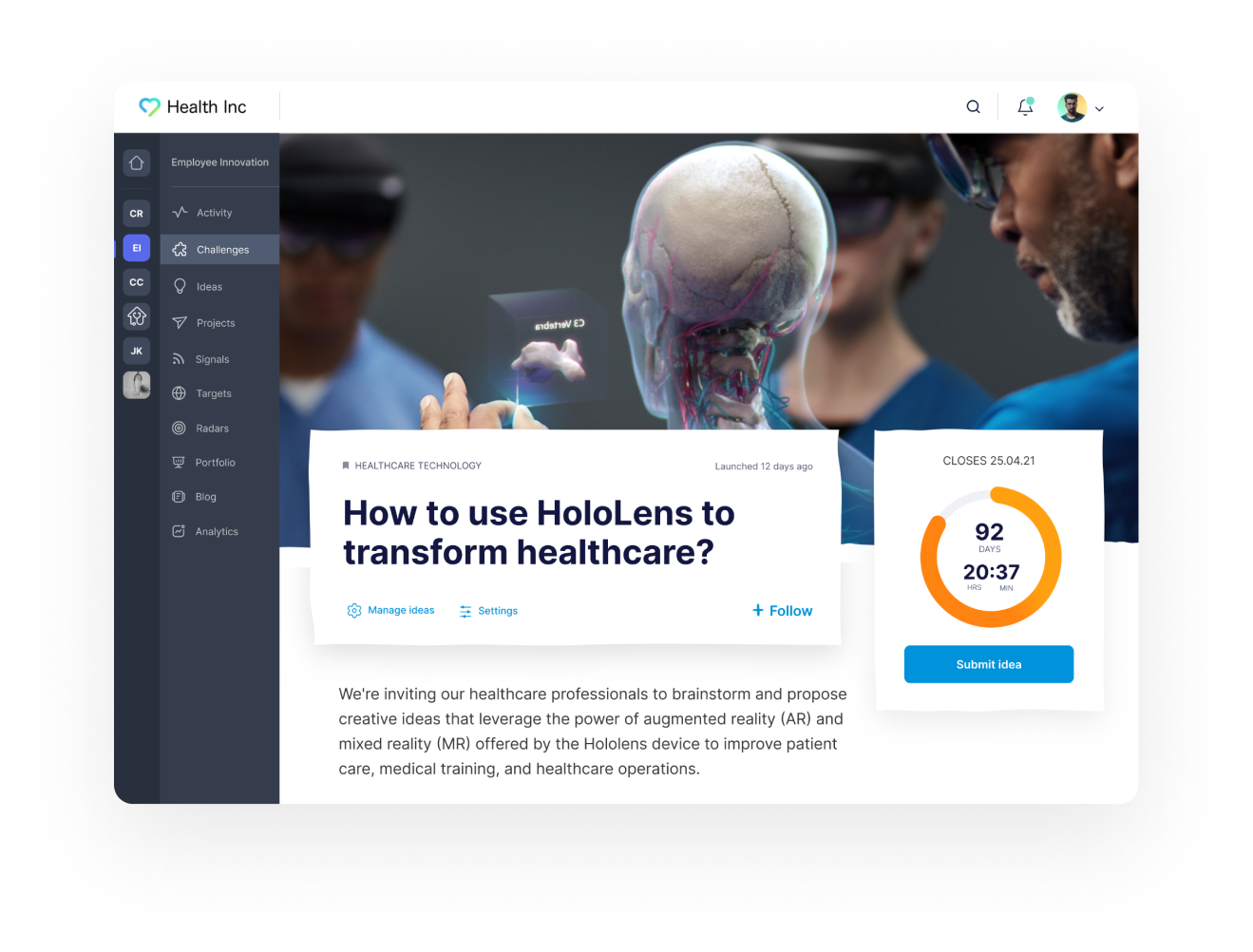
Like “Always On,” challenges allow innovation managers to create submission forms that dig deeper into the user’s idea and help them convey the envisioned value of their ideas.
These submission forms, alongside the resources inside each challenge, ultimately lead to better user responses.
Finally, innovation managers can add deadlines for when challenges close, so users know how urgent it is to submit their ideas.
Read more: 7 Strategies to Get Innovative Ideas from Employees
How Innovation Managers Can Open Up Idea Feedback to Everyone Inside the Company
It’s important to remember that most users won’t submit ideas that are perfect and ready to launch. Almost all ideas need some level of iteration.
However, a limitation of many innovation management platforms is that they have users give feedback on ideas by simply voting on them. Users can give an idea a thumbs up or thumbs down, but they aren’t encouraged to share feedback with original authors. While this approach can give you an understanding of which ideas are most popular, there’s no opportunity to improve the idea.
That’s why we added voting and discussion features within InnovationCast: to encourage everyone inside the organization to suggest improvements.
The goal is to avoid popularity contests based on votes and focus the community on providing actionable feedback to make ideas as good as possible.
Voting & Discussion Features
When someone shares an idea, innovation managers can display them for others to see.
Users can share their opinion by voting on any idea and saying if it “Looks good,” “Not so good,” or they are “Undecided.”
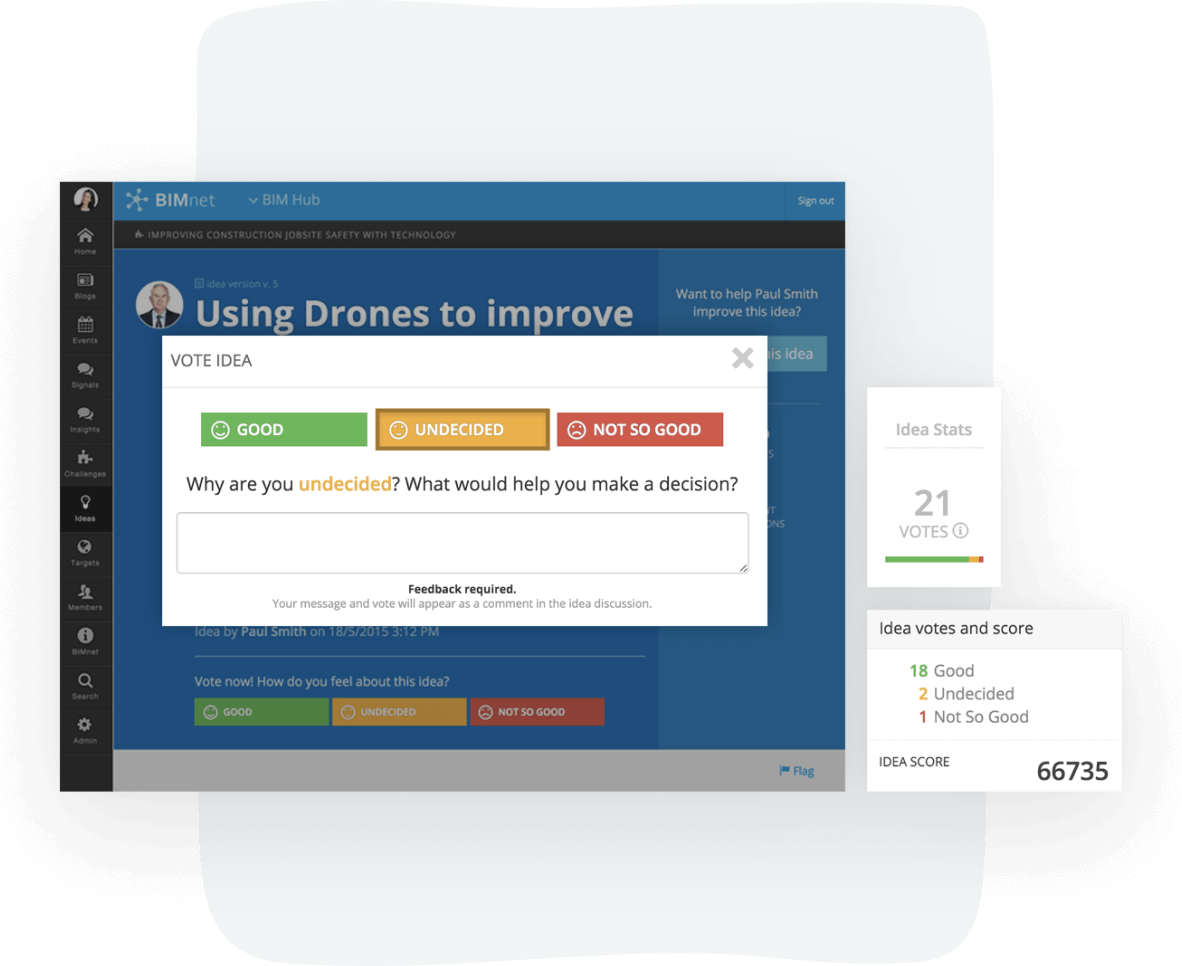
InnovationCast then asks them to share the reason they think an idea is good or not good, and if they are undecided, what information they need to make a decision.
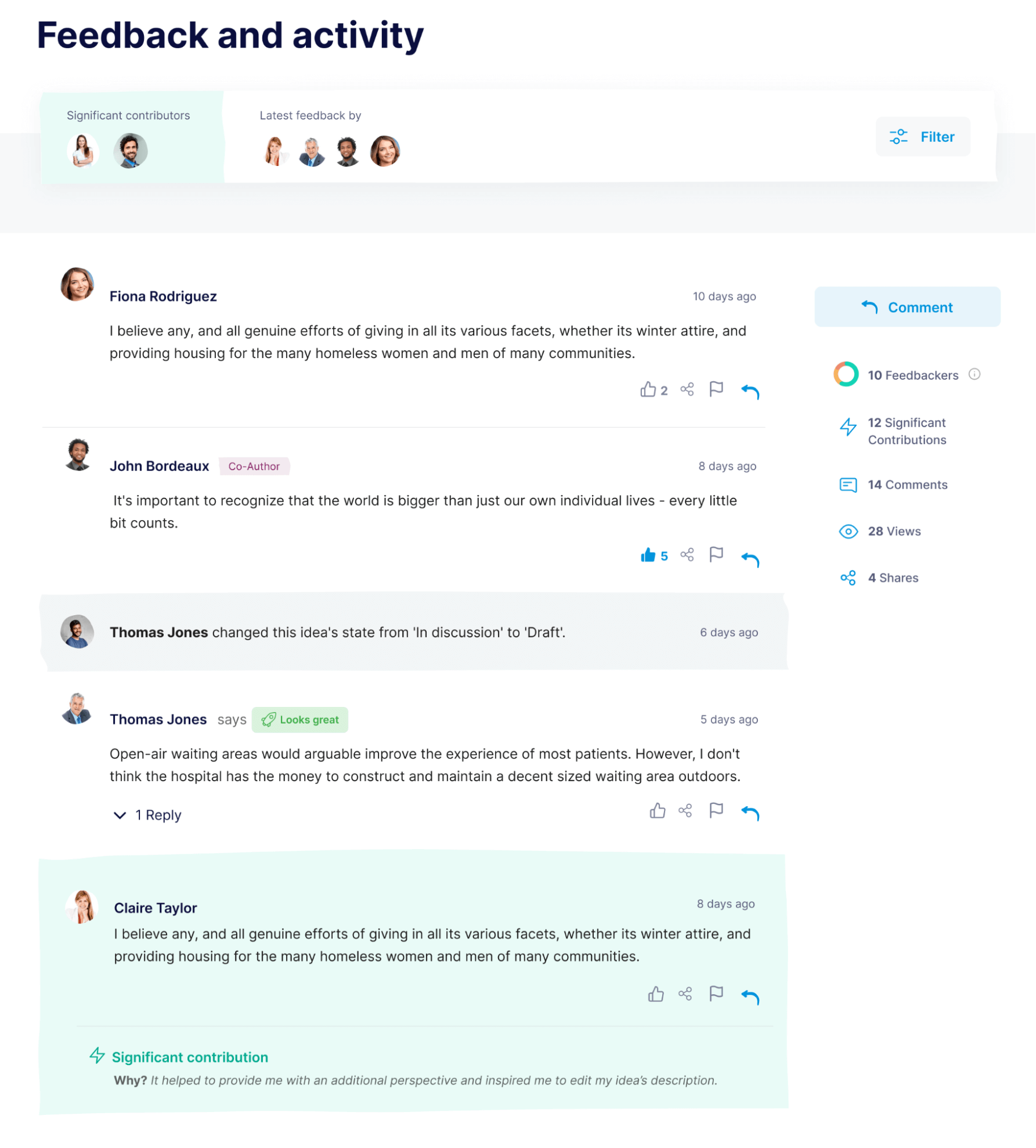
The original author can then implement this feedback to iterate upon their idea. This improvement step allows them to mature the idea before it’s assessed, increasing the likelihood that department leaders will select their idea for validation.
The benefit to department leaders is that they receive higher-quality ideas because everyone inside the organization (product development, marketing, legal, HR departments, etc.) already used their respective skill sets to improve the idea.
Read more: Best Practices to Evaluate Innovation Ideas
How Innovation Managers Can Validate & Implement Ideas
As we’ve written about before, a critical component of successful innovation programs at large organizations is having processes for idea evaluation, validation, and implementation. A lot of teams overlook these steps and over index just the collection step.
So, when designing InnovationCast, we paid special care to our idea evaluation workflows, which help bring clarity to the evaluation steps.
Once ideas are validated, innovation managers can plan implementation tasks inside our project manager and assign them to certain teams so everyone knows their role in launching the new innovation.
Additionally, with our portfolio manager, innovation departments can review past projects, identify issues that caused ideas to fall short of expectations, and adjust their current workflows to iron out these inefficiencies.
Idea Evaluation Workflows
After ideas are collected, innovation managers usually put them through an evaluation workflow before launching them. These evaluation workflows guide teams through the tasks (or experiments) they must complete to determine whether to implement an idea.
The key is that different types of ideas call for different evaluation workflows. For instance, product ideas require the development team to build an MVP before gathering customer feedback, whereas, factory assembly line process ideas often involve piloting new systems with a small team to assess productivity gains.
This is where many innovation management tools, including Qmarkets, begin to fall short. They only have a single evaluation workflow, and innovation managers have to push all ideas through it. If innovation managers want to create new workflows for different kinds of ideas or edit their existing one to launch ideas more efficiently, they have to contact the support team and sometimes pay additional fees or even go through custom software development processes.
Or, when innovation software doesn’t properly support idea validation, teams start moving validation offline, which kills transparency and impact tracking. What happens to the ideas at those steps becomes a black box.
So, instead of restricting innovation managers to one workflow, we designed InnovationCast with out-of-the-box workflows for different ideas. Product ideas, business model ideas, continuous improvement ideas, and internal process ideas all have their own dedicated workflows.
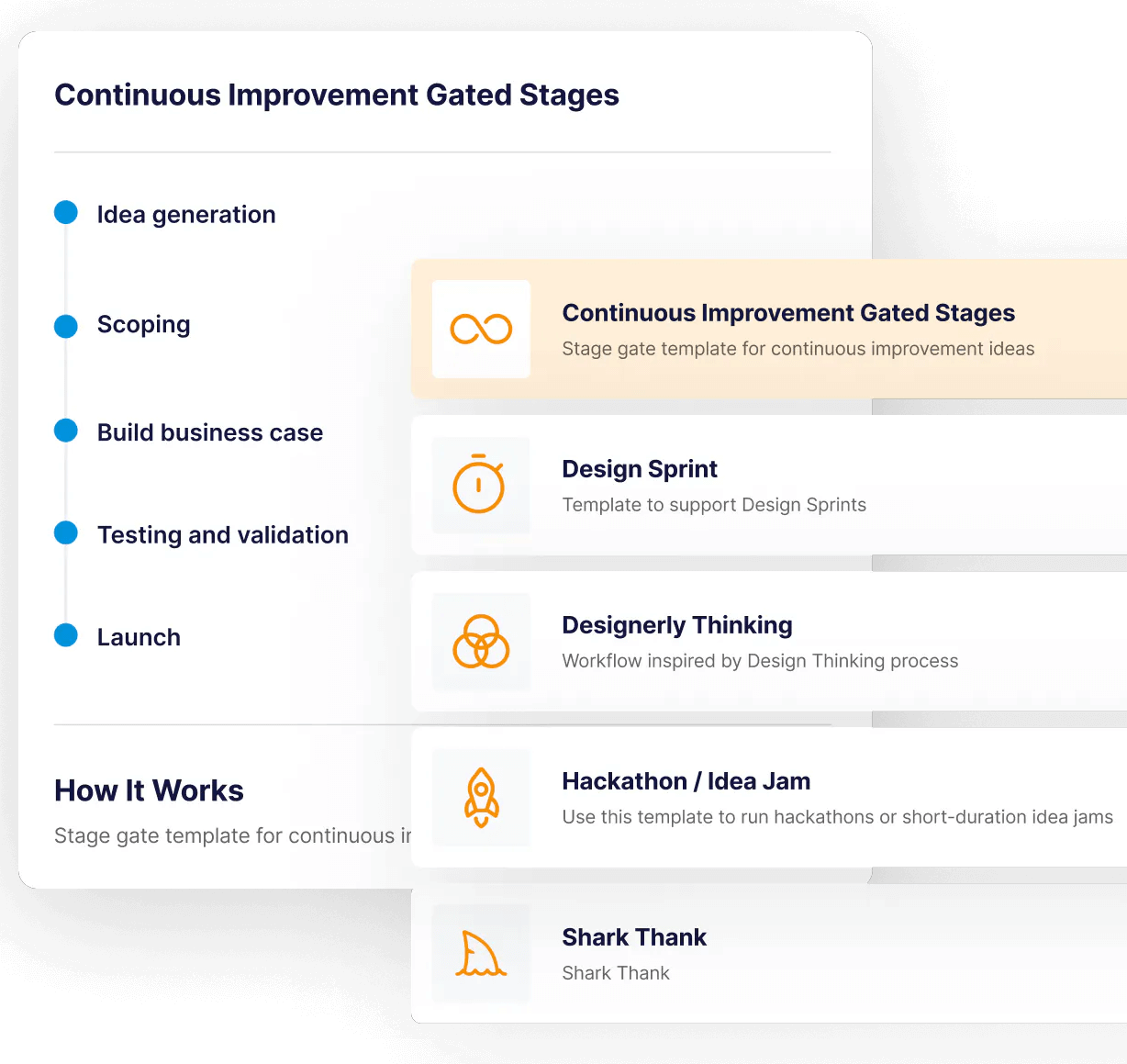
During onboarding, we help you create and customize these workflows around your company’s innovation priorities. However, you can edit them at any time by simply dragging and dropping steps or creating and adding new ones.
Project Manager
Once teams have validated ideas by running experiments, they can launch them using the project manager inside InnovationCast.
For each idea, users can plan the tasks that need to be completed (whether that’s building the full software product or sourcing materials at scale), assign them to specific teams, and then track the statuses of each team.
Users can create custom task cards containing information teams need to know before starting a project. This may include resources such as customer survey data, competitive analysis reports, or project requirements documents.
For instance, the screenshot below shows three in-progress projects: a patient-carer bootcamp, a mobile phone app, and a new waiting room MVP. Each project displays the owners’ names, current status (past due, done, stuck, planned), and start and finish dates.
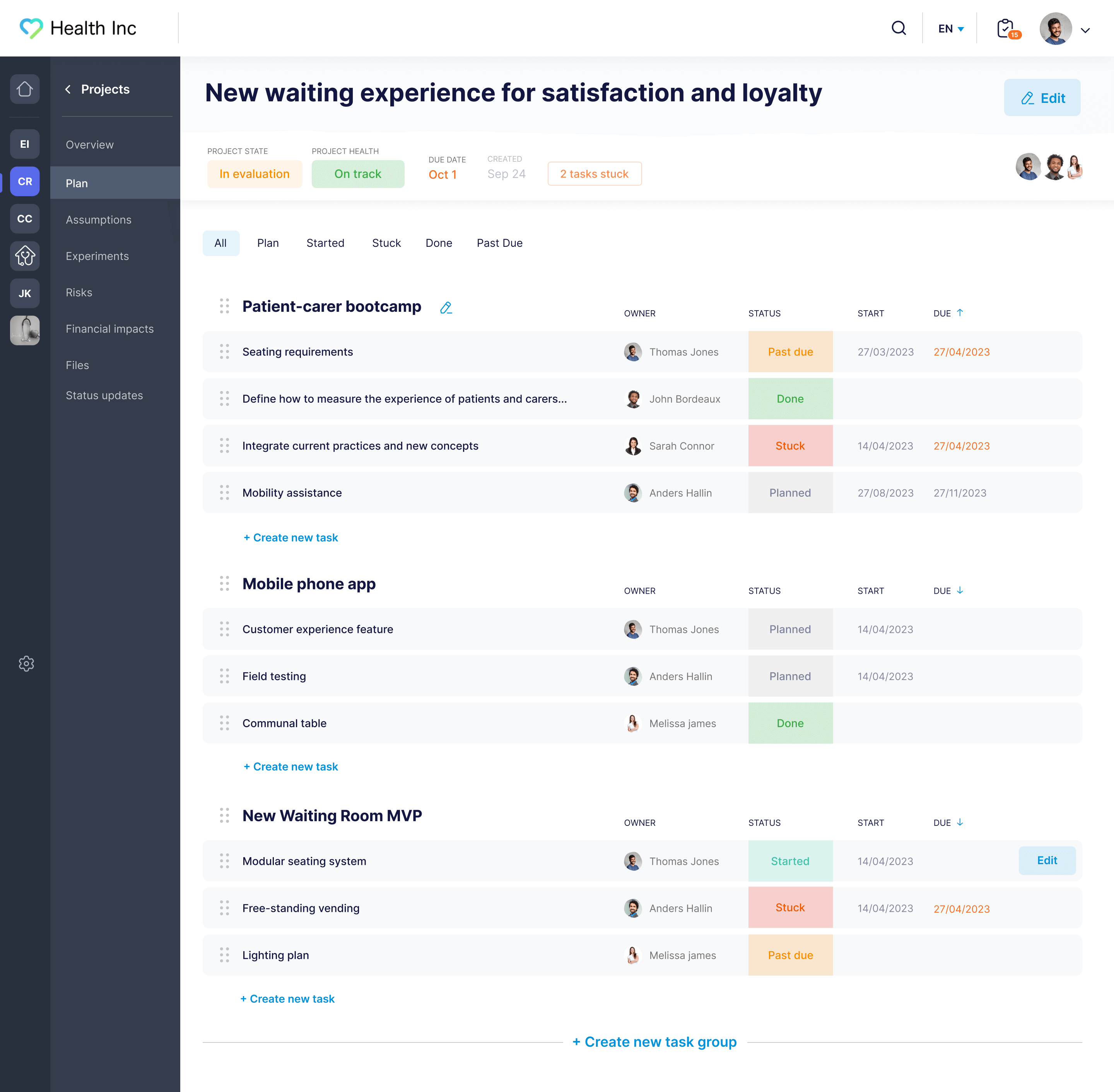
Innovation managers and stakeholders can open any one of these projects and get a more in-depth understanding of each team's progress, as well as anything that still needs to be completed.
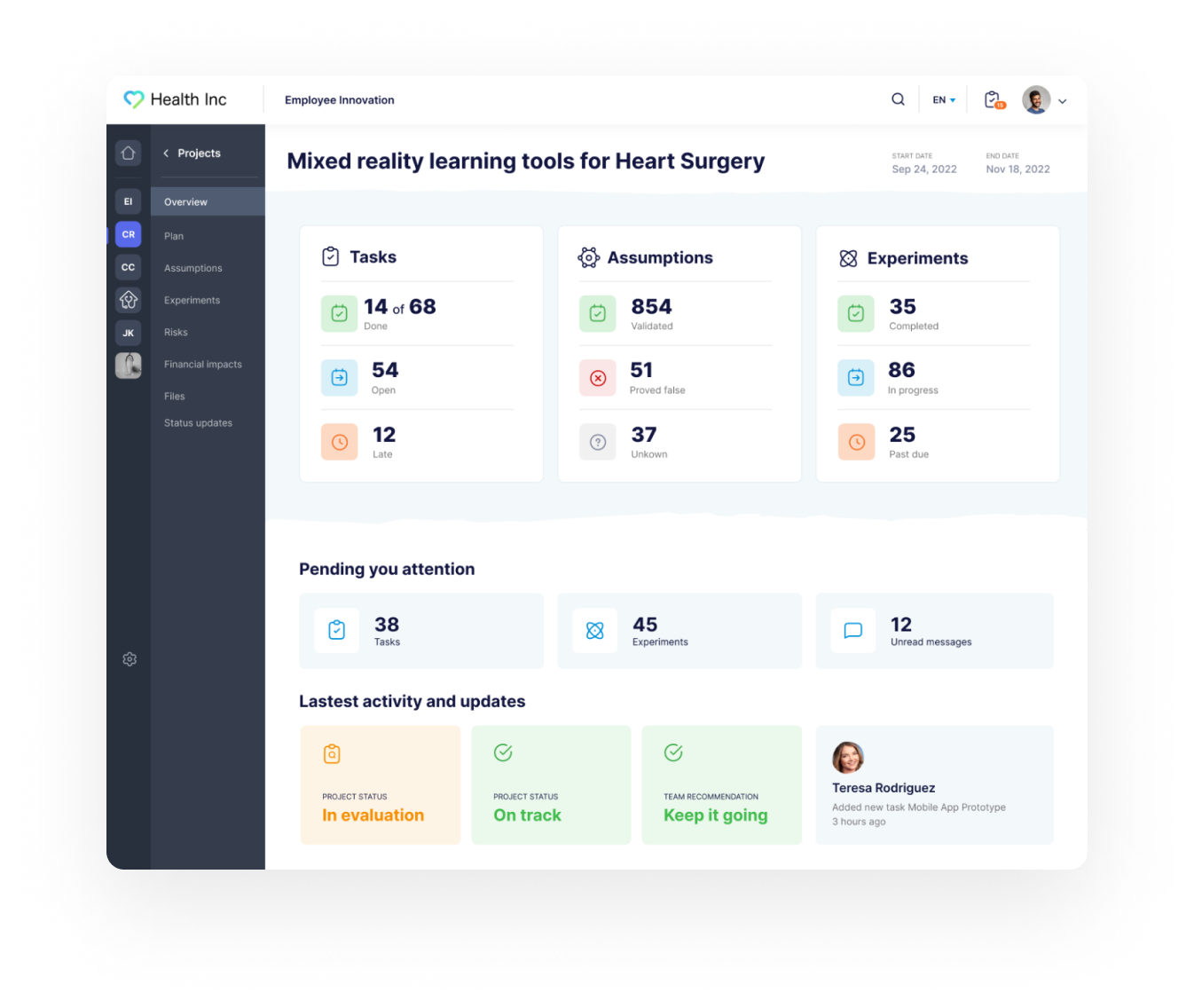
This way, everyone knows the plan for implementation, the tasks they are responsible for, and when they need to be completed.
Teams can comment inside task cards, ask others for help, report to innovation managers and stakeholders on their progress, and point out any roadblocks.
Moreover, our automation features can keep implementation tasks on track by notifying teams when their input is needed, what they need to do, and update stakeholders periodically on the status of each innovation.
Read more: How to Develop an Innovation Process to Launch New Ideas
Portfolio Manager
Innovation managers can use our portfolio manager to keep an organized record of all the ideas they have pursued in the past and track their impact on the company.
They can examine the implementation steps of past innovation projects — both successful and unsuccessful — and use these insights to understand what caused certain innovations to succeed and others to fail and how they can improve their workflows in the future.
Supplementary Features That Encourage Users to Participate in Innovation Initiatives
We understand that the foundation of a successful innovation program is the participation of employees from all corners of the organization (and perhaps even outside subject matter experts).
So, to keep these users engaged with company priorities and incentivize them to research, submit, and iterate upon ideas, we added the following features to InnovationCast.
Signals & Scouting
Employee badges & rewards
Onboarding training materials & email notifications
Signals & Scouting
Innovation managers can use our Signals & Scouting feature to stay informed about the latest industry trends and competitor news.
Signals & Scouting is a centralized news hub where users can share articles, press releases, and other resources they believe their colleagues and managers should know about.
When other users log into InnovationCast and visit their dashboard, they can view these resources alongside any active challenges and idea submissions. Everyone can then comment on a resource, discuss its importance, how it impacts the company, and if it requires any action.
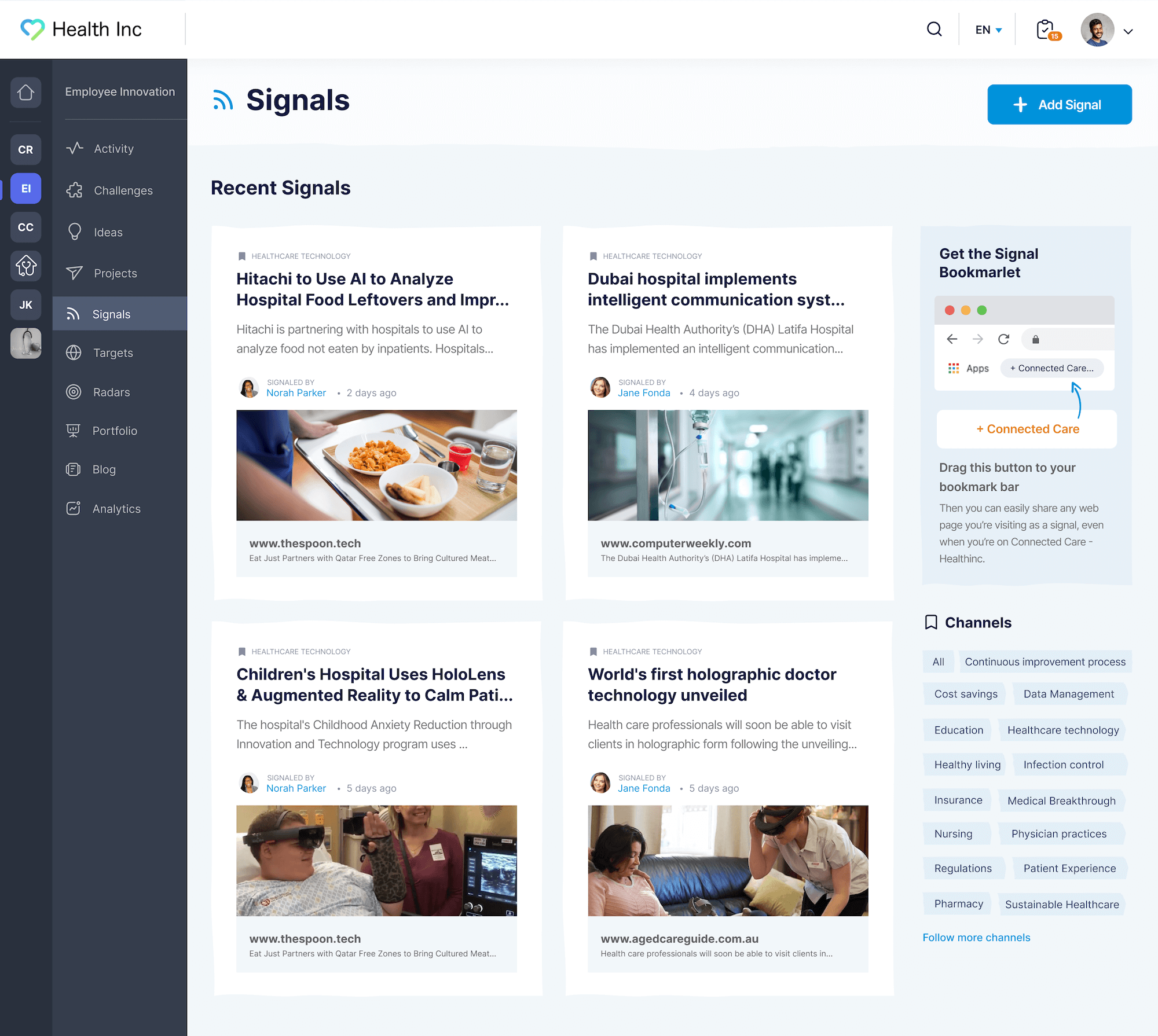
This also serves as a helpful tool for users who may not have original ideas to share but still want to contribute to innovation efforts; they can share news that they encounter in their day-to-day lives with others inside the company.
This allows innovation managers to create a more sustainable innovation program that draws insights from users beyond idea submission.
Employee Badges & Rewards
To encourage employees and outside users to engage with challenges and “Always On,” we designed InnovationCast with a badges and rewards system.
When users submit good ideas, are first to respond to a challenge, or achieve any other milestone, innovation managers can create badges and display them on the user’s profile for others to see.
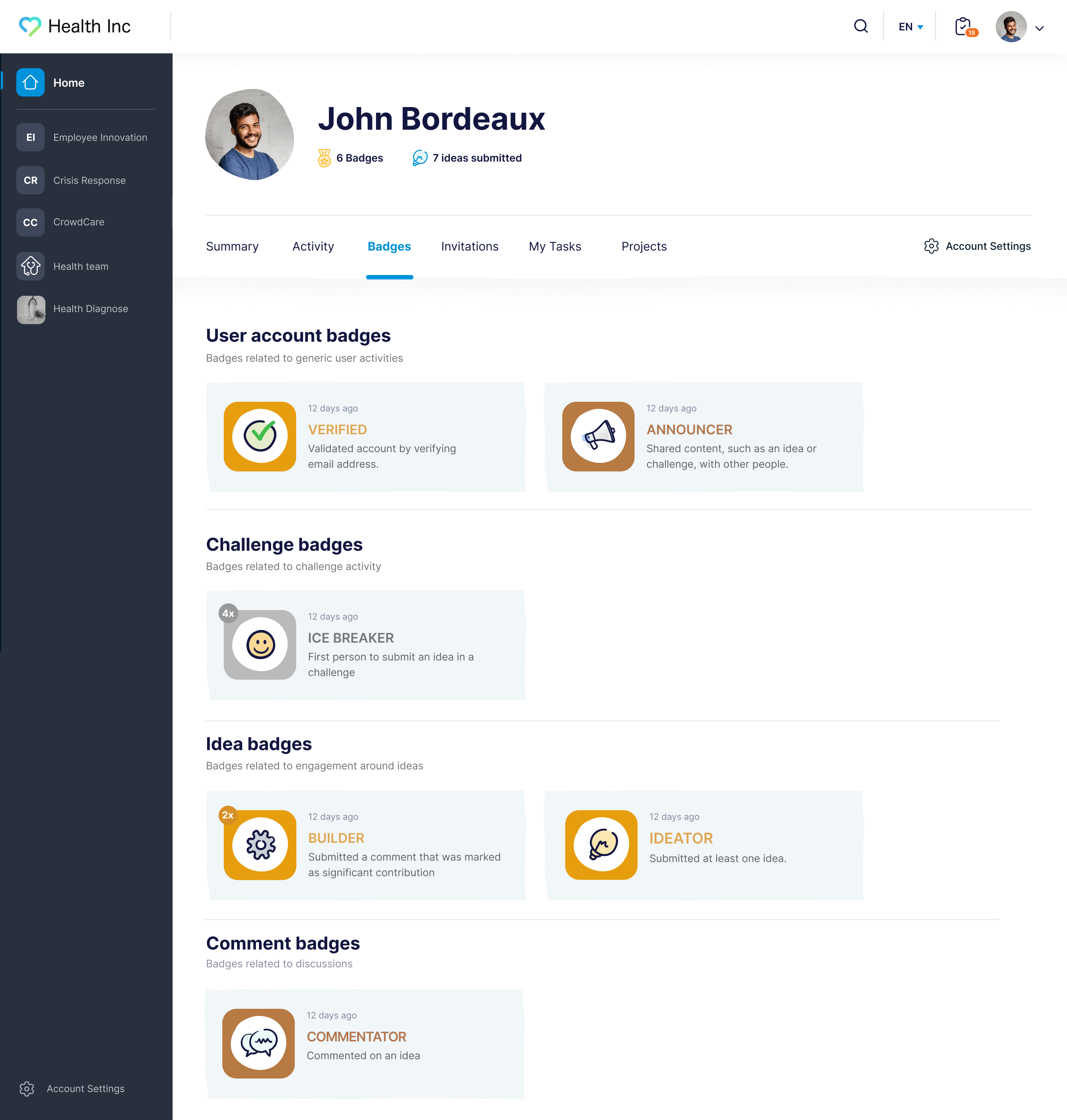
Innovation managers can also award points to users for completing certain tasks that they can then redeem for rewards. These rewards could be anything such as gift cards, cash prizes, PTO, or movie tickets. This way, users can contribute to innovation efforts and save up points that they can spend on their favorite reward.
Read more: How to Encourage Innovation in the Workplace
Onboarding Training Materials & Email Notifications
To ease the learning curve for new users, we added onboarding training materials to InnovationCast. These training materials contain resources that show employees how to respond to challenges and “Always On” and share insights via Signals.
Innovation managers can send these training materials to users they are looking to onboard. Then, these new users can watch a couple of videos and begin submitting ideas immediately.
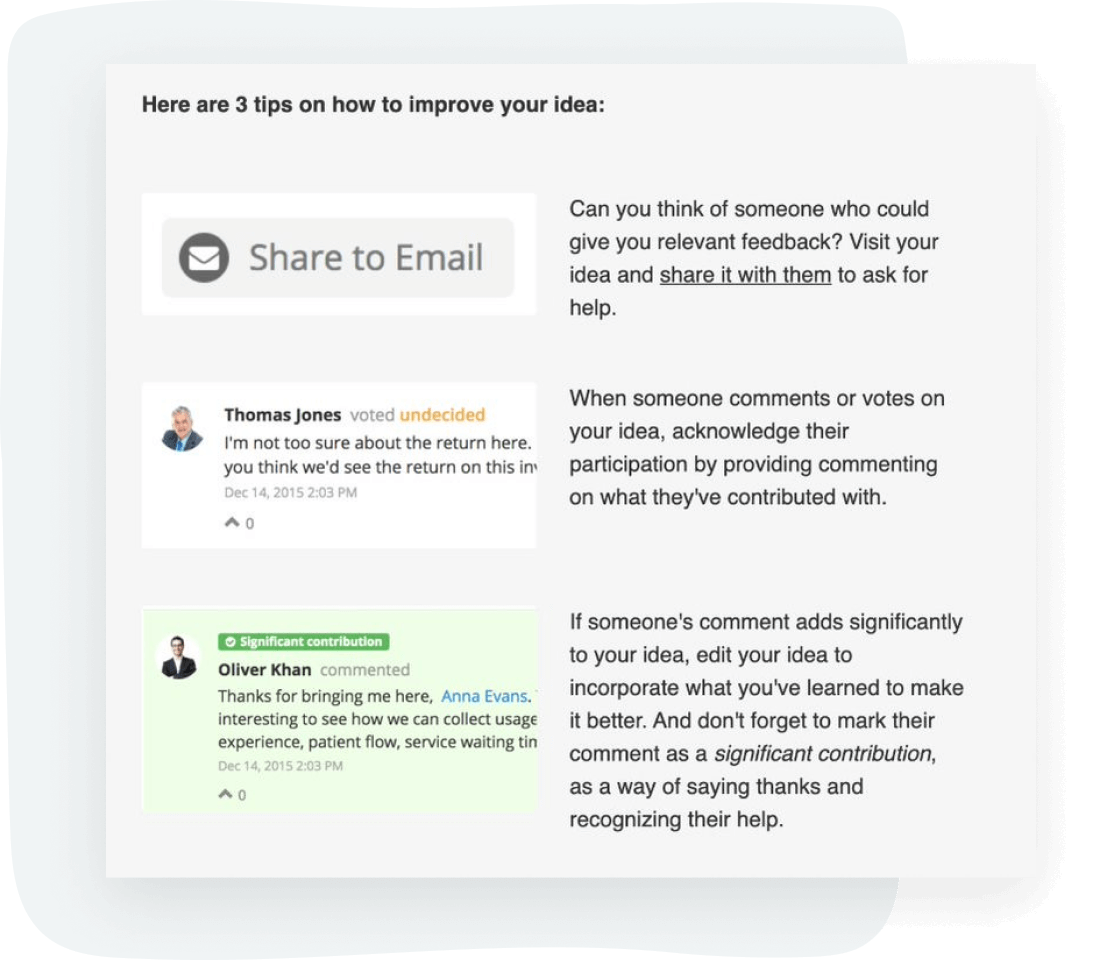
We have email reminders that innovation managers can utilize when they are looking for new ideas. These emails nudge users to submit ideas or comment on their colleague’s ideas, reminding everyone to participate in innovation efforts.
Get Started
DHL, Novo Nordisk, ING, and Visa have all used InnovationCast to establish a culture of innovation within their companies. You can schedule a free demo to learn more about how our solution can help your company.
2. Brightidea
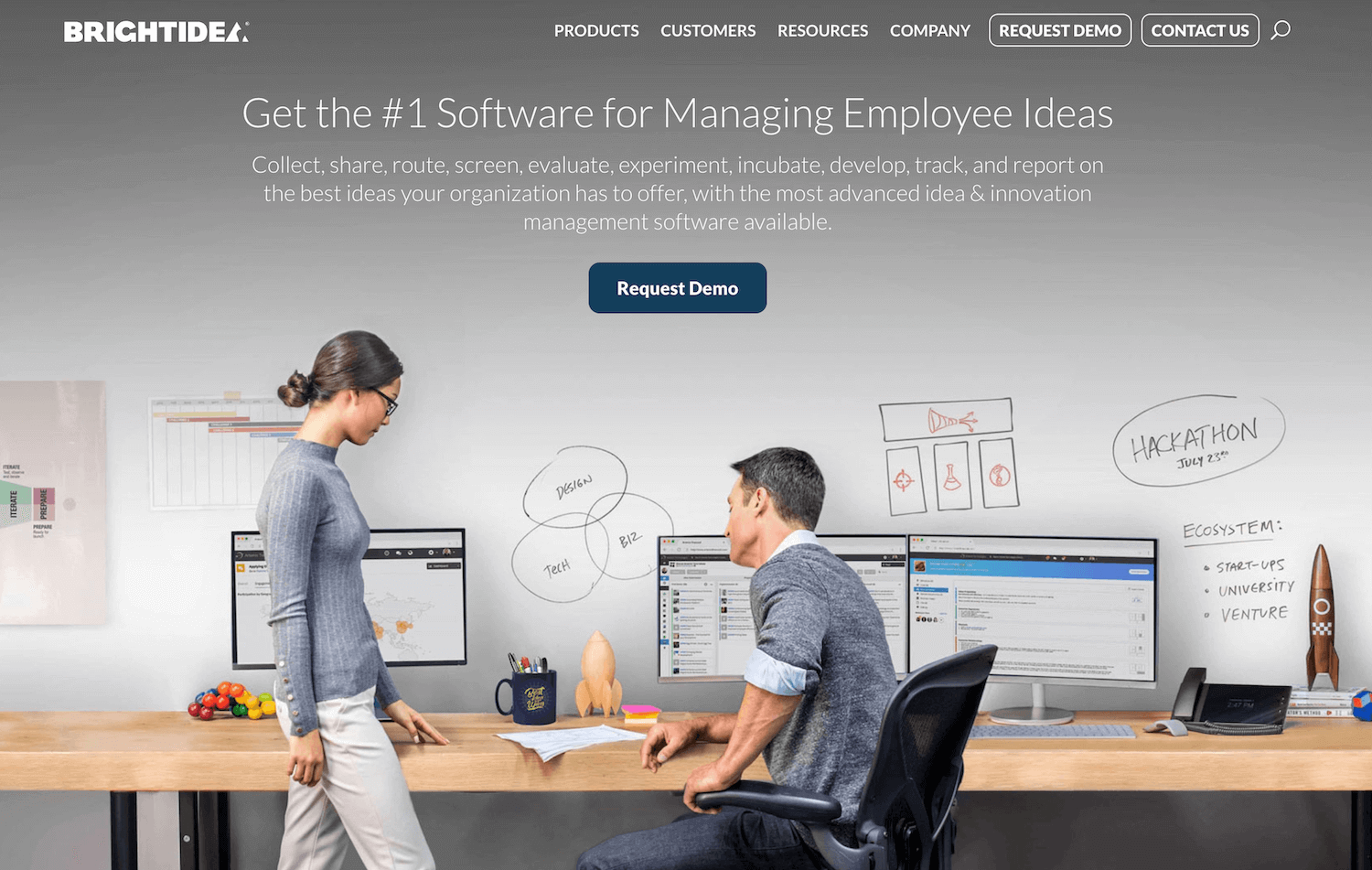
Brightidea is innovation management software targeted toward enterprise companies that want to utilize their employees' creativity to implement innovative products and processes.
Brightidea has the features required for innovation managers to collect ideas from employees, customers, and other user groups. Then, they can filter the best ideas by crowdsourcing feedback from different departments. Stakeholders can move forward with these ideas by validating and launching them inside evaluation workflows.
Features
Program — Innovation managers can create challenges around company priorities and ask employees and other users to share ideas.
Idea box — Innovation managers can allow users to submit ideas on more general company priorities 24/7. This way, they can collect ideas even when there aren't any challenges open.
Hackathon — Innovation managers can inform programmers inside and outside the company about any priorities they are tasked with and ask them to build software solutions to address them.
Lab — Innovation managers can centralize all ideas inside the Lab, give stakeholders and employees access to them, create custom permissions, and use Brightidea’s collaboration tools to encourage employees to work together and refine ideas.
Ecosystem — This is Brightidea's external innovation functionality. It allows innovation managers to call on the expertise of outside users such as researchers, universities, and students to help scout new technologies.
Transformation and roadmaps — Innovation managers can streamline the launch of products and processes by creating tasks inside Brightidea's project manager and assigning them to certain teams.
Pricing
Brightidea doesn't publicly disclose its pricing plans. However, some users have reported that their monthly plans start at $59.
3. HYPE Innovation
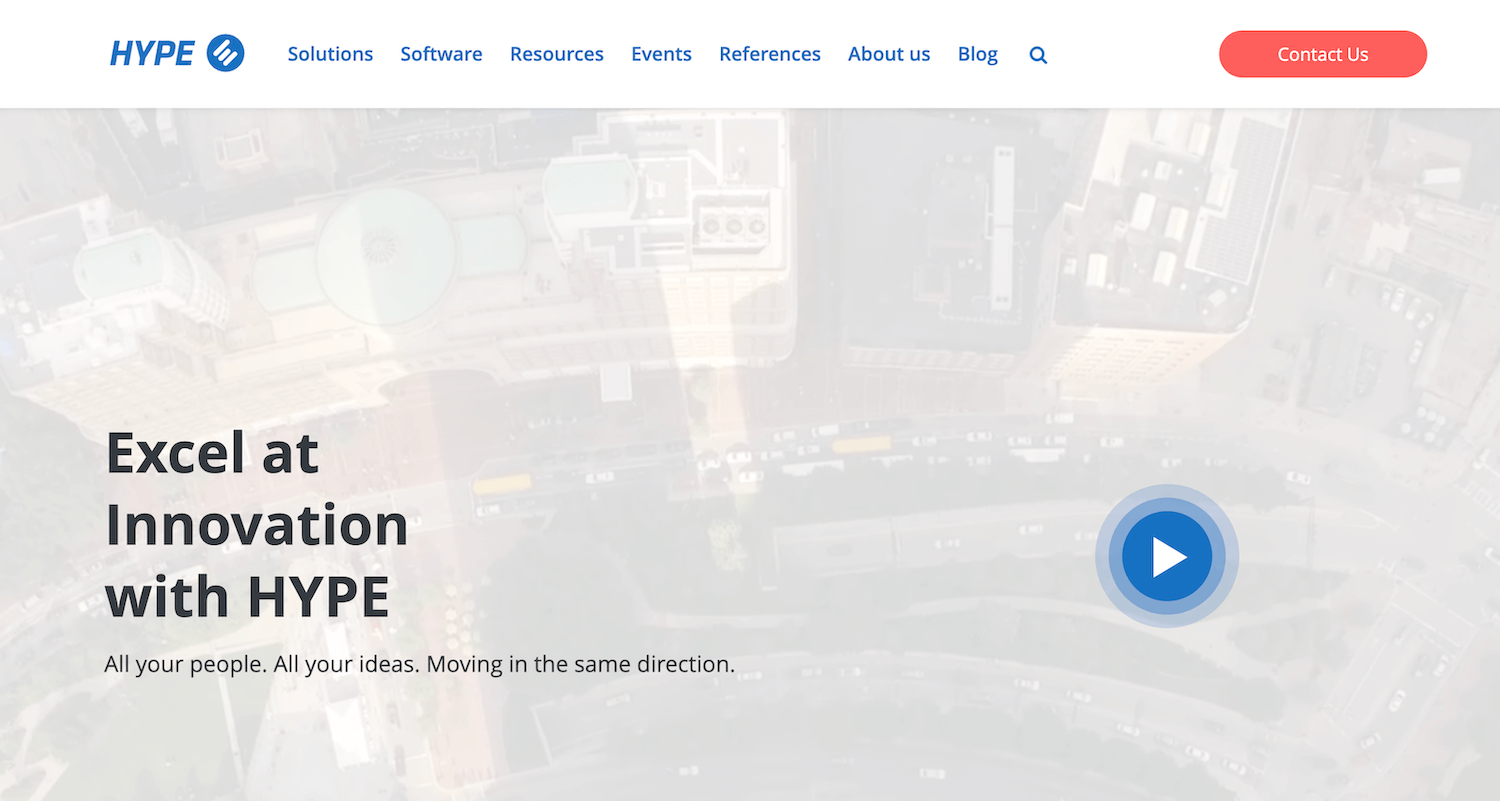
HYPE Innovation is an end-to-end enterprise innovation platform that aims to help teams of all sizes (small businesses to enterprise companies) manage innovation effectively. They offer the features needed for innovation managers to collect, develop, test, and implement ideas.
Additionally, HYPE Innovation has an idea management software called Viima that specializes in helping innovation managers collect ideas and gather feedback on them.
Features
Idea generation and brainstorming — Innovation managers can collect ideas aligned with their company's overarching vision. They can set up campaigns, inform users about priorities, and ask them to share ideas.
Technology scouting — Innovation managers can use HYPE's database of over 10,000 SaaS technologies and startups to identify potential threats, opportunities, and partnerships in real-time.
Trend management — Innovation managers can track global trends and encourage users to submit ideas that address these trends.
Employee engagement — Innovation managers can encourage employees to share ideas by offering rewards, innovation flairs, and public recognition.
Hackathons templates — Innovation managers can ask programmers and other technical employees to build products that solve certain problems the company is facing.
Pricing
HYPE Innovation doesn't display any pricing plans on its website. You have to book a demo with their customer success team, and they'll give you a custom quote.
4. ITONICS
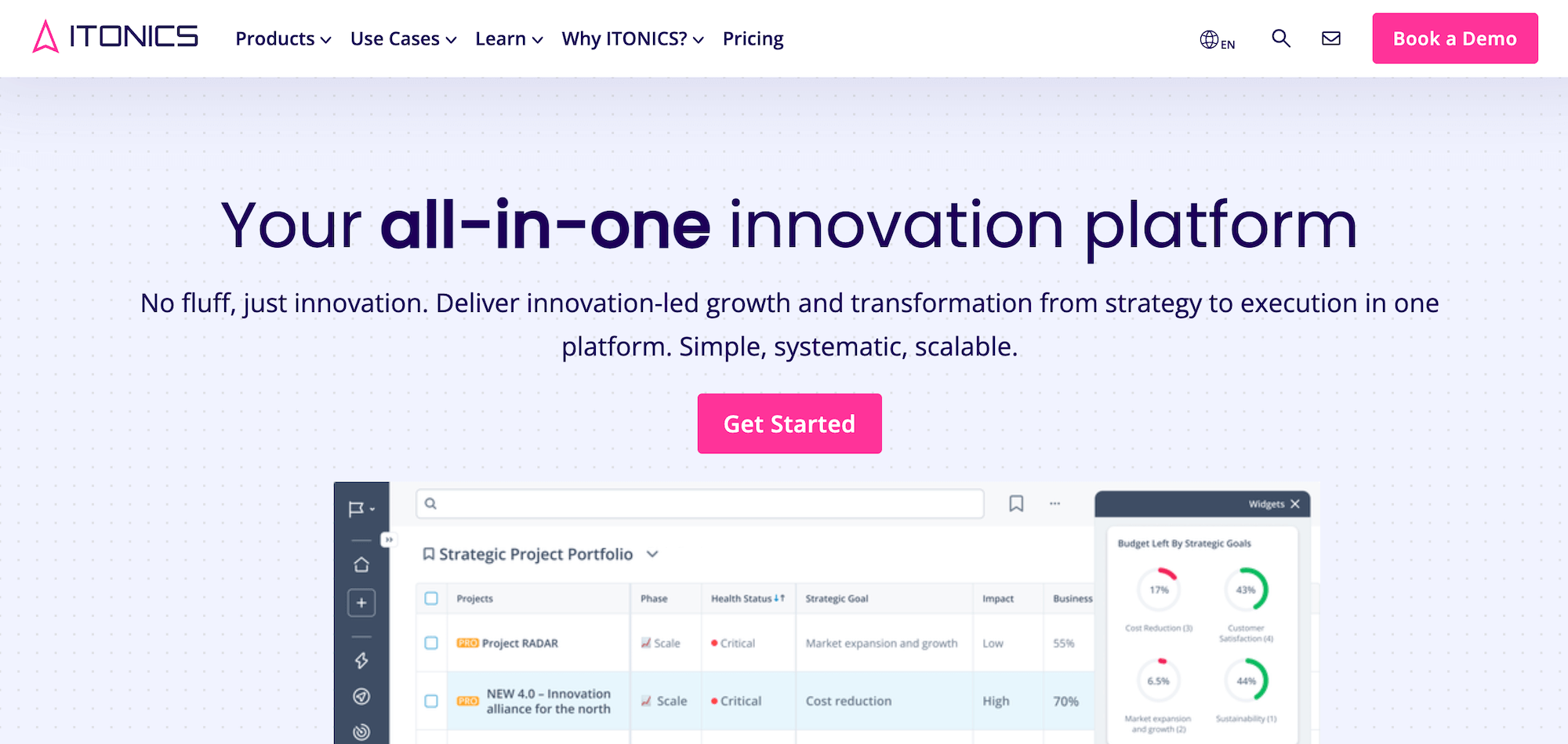
ITONICS is an innovation portfolio management system with an ecosystem of tools meant to help teams connect and work together to address priorities related to the innovation strategy.
In addition to the features required to collect ideas and move them forward to implementation, ITONICS also comes with AI-powered features to automate evaluation workflows.
However, it's important to remember that while ITONICS' customer success team will help you with the initial setup, users may need additional training on the platform’s workspace due to its complexity.
Features
Foresight — Where employees and outside users can share resources on the latest news and trends around topics the company is trying to address. This way, innovation managers can quickly identify potential opportunities and use them to fuel ideation.
Ideation — Innovation managers can build campaigns to educate users about the innovation strategy and invite them to share their ideas. They can then create forms that employees are required to complete before submitting their ideas, encouraging them to share more details.
Portfolio — Innovation managers can get an overview of all the projects launched in the past. Then, they can use various data points and metrics to track the impact of these live innovations.
AI idea generation — This AI feature recommends which ideas innovation managers should pursue and which ones to table.
Pricing
ITONICS’ website says that it offers three plans: Team, Professional, and Enterprise.
We recommend the Professional plan because it includes configurable evaluation workflows for validating and implementing ideas and a dedicated customer success manager to help you set everything up.
It's worth mentioning that many users complain ITONICS’ pricing plans are very rigid. To add features or customize certain settings, you need to upgrade to another plan. So, ITONICS might not be the most scalable innovation management platform.
5. Wazoku
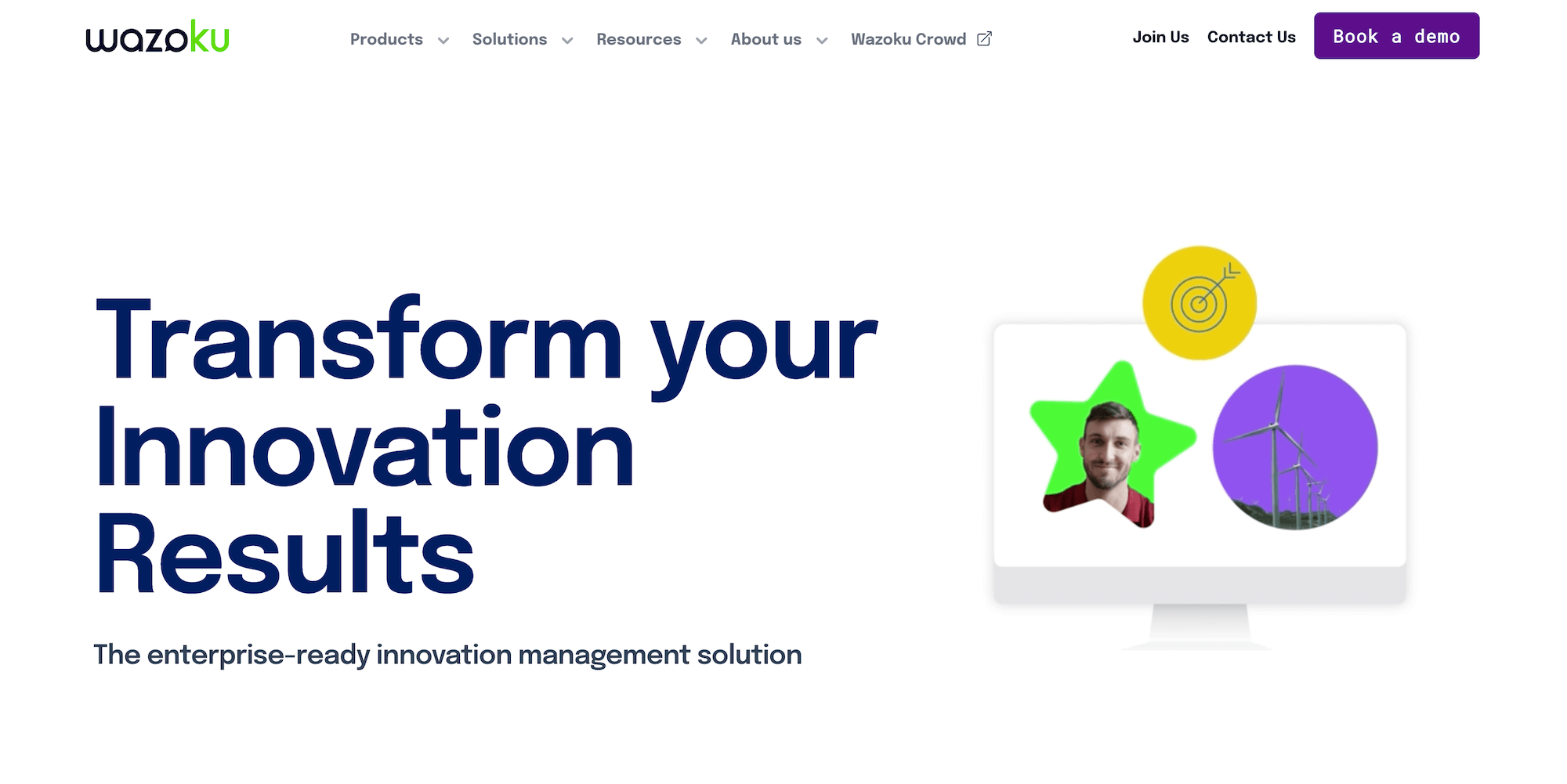
Wazoku is a comprehensive innovation management platform specializing in helping enterprise companies collect innovative ideas and launch products and processes that benefit their bottom line.
Like the other idea management platforms above, Wazoku's customer success team joins you on a call during onboarding to help familiarize you with all the features and show you how to tailor their platform around your specifications.
Features
Internal innovation — Where innovation managers can collect ideas from employees and other internal users, use gamification to encourage participation, reward them for their contributions, and offer training materials.
Open innovation — Where innovation managers can invite outside users to share ideas and develop APIs that can potentially address company priorities.
Co-creation — Where innovation managers can encourage employees, stakeholders, and outside users to leave feedback and rate idea submissions.
Tech scouting — Where innovation managers can stay up to date on the latest technology news and partner with startups to solve organizational problems together.
Pulse surveys — Where innovation managers can create custom surveys, send them to users, and gather feedback on certain topics.
Innovation networks — Where innovation managers can use Wazoku’s messaging feature to connect with teams from around the world to solve problems they have in common. Then, the best ideas and technologies are displayed at Wazoku's annual showcase.
Pricing
In order to receive a custom quote, you need to contact their support team.
Collect Innovative Ideas and Turn Them Into Shippable Products With InnovationCast
There are four things you should look for when shopping for a Qmarkets alternative:
Features to provide employees and outside users with information about your innovation strategy and prompt them to submit ideas.
Features to open up idea assessment to all users; everyone should be able to view ideas, leave comments, and work alongside original idea contributors to edit ideas.
The ability to create multiple workflows to validate and launch different kinds of ideas as well as edit workflow steps around your business processes.
Thorough project management so you can take green-lit ideas over the finish line.
We specifically designed InnovationCast to tick all of these boxes. During onboarding, we walk you through how to create detailed postings to collect ideas and set up evaluation workflows.
If you’d like to see how InnovationCast can help your company utilize the brainpower of all employees to collect high-quality ideas and develop them into innovative products and processes, book a free demo with our customer success team.
Related reads:

